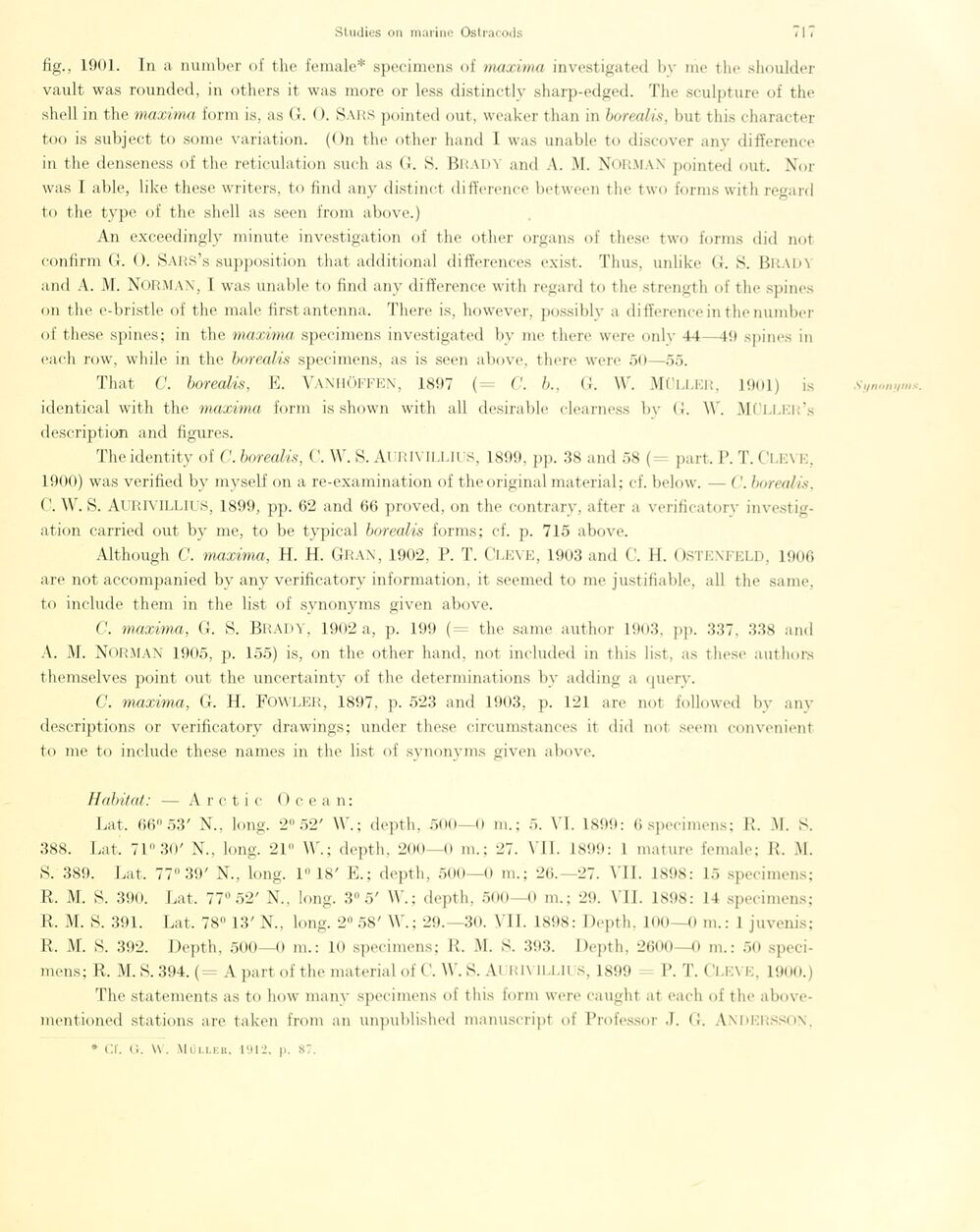
Full resolution (JPEG) - On this page / på denna sida - Sidor ...

<< prev. page << föreg. sida << >> nästa sida >> next page >>
Below is the raw OCR text
from the above scanned image.
Do you see an error? Proofread the page now!
Här nedan syns maskintolkade texten från faksimilbilden ovan.
Ser du något fel? Korrekturläs sidan nu!
This page has never been proofread. / Denna sida har aldrig korrekturlästs.
fig., 1901. In a number of the female* specimens of maxima investigated by me the shoulder
vault was rounded, in others it was more or less distinctly sharp-edged. The sculpture of the
shell in the maxima form is, as G. 0. SARS pointed out, weaker than in borealis, but this character
too is subject to some variation. (On the other band I was unable to discover any difference
in the denseness of the réticulation such as G. S. BRADA and A. M. NORM A X pointed out. Nor
was I able, like these writers, to find any distinct difference between the two forms witli regard
to the type of the shell as seen from above.)
An exceedingly minute investigation of the other organs of these two forms did not
confirm G. 0. Sars’s supposition that additional differences exist. Thus, unlike G. S. Brada
and A. M. NORMAN, I was unable to find any difference with regard to the strength of the spines
on the e-bristle of the male first antenna. There is, however, possibly a difference in the number
of these spines; in the maxima specimens investigated by me there were only 44—19 spines in
each row, while in the borealis specimens, as is seen above, there were 50—55.
That C. borealis, E. VANHÖFFEN, 1897 ( = C. b., G. W. MÜLLER, 1901) is
identical with the maxima form is shown with all desirable clearness by G. V. Müller’s
description and figures.
The identity of C. borealis, C. W. S. Al’RIYIELIUS, 1899, pp. 38 and 58 (= part. P. T. Cleye,
1900) was verified by myself on a re-examination of the original material; cf. below. — C. borealis,
C. W. S. AURIVILLIUS, 1899, pp. 62 and 66 proved, on the contrarv, after a verificatory
investigation carried out by me, to be typical borealis forms; cf. p. 715 above.
Although C. maxima, H. H. Gran, 1902, P. T. Cleye, 1903 and C. H. OSTEXFELD, 1906
are not accompanied by any verificatory information, it seemed to me justifiable, all the same,
to include them in the list of synonyms given above.
C. maxima, G. S. BRADA’, 1902 a, p. 199 ( the same author 1903, pp. 337. 338 and
A. M. NORMAN 1905, p. 155) is, on the other hånd, not included in this list, as these authors
themselves point out the uncertainty of the determinations by adding a query.
C. maxima, G. H. FOWLER, 1897, p. 523 and 1903, p. 121 are not followed by any
descriptions or verificatory drawings; under these circumstances it did not seem convenient
to me to include these names in the list of synonyms given above.
Habitat: — Arctic Ocean:
Lat. 66" 53’ N., long. 2° 52’ W.; depth, 500—0 m. ; 5. VI. 1899: 6 specimens; R. M. S.
388. Lat. 71° 30’ N., long. 21" W.; depth, 200—0 m.; 27. VII. 1899: 1 mature female; R. M.
S. 389. Lat. 77" 39’ N., long. 1" 18’ E.; depth, 500—0 m.; 26.—27. VII. 1898: 15 specimens;
R. M. S. 390. Lat. 77° 52’ N., long. 3" 5’ IV.; depth, 500—0 m.; 29. VII. 1898: 14 specimens;
R. M. S. 391. Lat. 78" 13’ N., long. 2" 58’ \\\; 29.—30. VII. 1898: Depth, 100—0 m.: 1 juvenis;
R. M. S. 392. Depth, 500—0 m. : 10 specimens; R. M. S. 393. Depth, 2600—0 m. : 50
specimens; R. M.S.394.(= A part of the material of C. V. S. AtRlYlLl.il s, 1899 P. T. CLEYE, 1900.)
The statements as to how many specimens of this form were caught at each of the
above-mentioned stations are taken from an unpublished manuscript. of Professor J. G. Andersson.
.V i/noni/in
Cl. G. W. Müller. 191*2, p. 87.
<< prev. page << föreg. sida << >> nästa sida >> next page >>